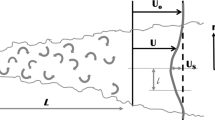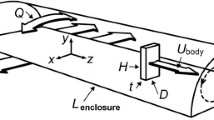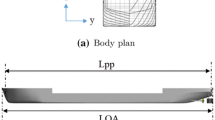Abstract
This paper proposes a novel coupled experimental and numerical simulation for the evolution of bubbly wake of ship models in confined towing tank basins. Firstly, near-field bubbly wake characteristics of the model ship are obtained using optical light scattering measurements which provide the temporal variations of the integrated wake strength, its spatial distribution, and bubble size analysis. Then computational fluid dynamic tools combined with a bubble clouds tracking method are implemented to study the wake attenuation in the far-field region. A comparison of the bubbly wake evolution in confined and unconfined mediums is also presented. Results show that the bubbly wake properties of a model ship towed in a confined channel may differ from a model towed in the open water. The main difference rises from the flow fluctuations induced by the confined channel which can lead to different wake persistence times. However, using the proposed schemes allows linking the near-field data obtained in towing tanks, with the wake attenuation behaviors of an open far-field domain hence, providing a feasible solution for a complex problem. Numerical results draw the importance of bubble dissolution and buoyant effects in the attenuation of bubbly wake in the far-field region.


















Similar content being viewed by others
Data availability
The authors confirm that the data supporting the findings of this study are available within the article.
References
Luo Y, Zhang C, Liu J, Xing H (2022) Identifying ship-wakes in a shallow estuary using machine learning. Ocean Eng 246:110456
Tings B, Velotto D (2018) Comparison of ship wake detectability on C-band and X-band SAR. Int J Remote Sens 39(13):4451–4468
Zaggia L, Lorenzetti G, Manfé G (2017) Fast shoreline erosion induced by ship wakes in a coastal lagoon: field evidence and remote sensing analysis. PLoS ONE 12(10):e0187210
Liu Y, Zhao J, Qin Y (2021) A novel technique for ship wake detection from optical images. Remote Sens Environ 258:112375
Hendrickson K, Weymouth G, Banerjee S, Yue D (2013) Air entrainment and multiphase turbulence in the bubbly wake of a transom stern. Int Shipbuild Prog 60:375–401
Hendrickson K, Weymouth G, Yu X, Yue D (2019) Wake behind a three-dimensional dry transom stern. Part 1. Flow structure and large-scale air entrainment. J Fluid Mech 875:854–883
Yasuda T, Mutsuda H, Mizutani N, Matsuda H (1999) Relationships of plunging jet size to kinematics of breaking waves with spray and entrained air bubbles. Coast Eng J 49:269–280
Hsiao CT, Chahine G (2012) Effect of a propeller and gas diffusion on bubble nuclei distribution in a liquid. J Hydrodyn 24(6):809–822
Javanmard E, Yari E, Mehr J (2020) Numerical investigation on the effect of shaft inclination angle on hydrodynamic characteristics of a surface-piercing propeller. Appl Ocean Res 98:102108
Yari E, Ghassemi H (2016) Numerical analysis of surface piercing propeller in unsteady conditions and cupped effect on ventilation pattern of blade cross-section. J Mar Sci Technol 21:501–516
Donghua Z, Jionghui R, Xiaohui Z, Chun SS (2007) Research on ship wake detection by optical method of small angle forward scattering. Beijing, China, s.n.
Trevorrow M, Vagle S, Farmer D (1994) Acoustical measurements of microbubbles within ship wakes. J Acoust Soc Am 95(4):1922–1930
Suneela J, Krishnankutty P, Subraman A (2021) Hydrodynamic performance of planing craft with interceptor-flap hybrid combination. J Ocean Eng Marine Energy 7:421–438
Yuan Z-M et al (2018) Side wall effects on ship model testing in a towing tank. Ocean Eng 147:447–457
Raven H (2019) A method to correct shallow-water model tests for tank wall effects. J Mar Sci Technol 24:437–453
Terril E, Melville K (1998) A broadband acoustic technique for measuring bubble size distributions: laboratory and shallow water measurements. J Atmos Oceanic Tech 17:220–239
Ling-Guo Z et al (2018) Simulation and statistical modeling of acoustic scattering of bubble wakes. Math Problems Eng 2018:1–18
Rychert K, Weber T (2020) Tests of acoustic target strength and bubble dissolution models using a synthetic bubble generator. J Atmos Oceanic Tech 37(1):129–140
Liu Y, Deng R (2018) Ship wakes in optical images. J Atmos Oceanic Tech 35(8):1633–1648
Zhang X, Lewis M, Johnson B (1998) Influence of bubbles on scattering of light in the ocean. Appl Opt 37(27):6525–6536
Li W et al (2009) Influence of characteristics of micro-bubble clouds on backscatter lidar signal. Opt Express 17(20):1–12
Song J, Bian L, Yang E, Su D (2018) Bubble density gradient with laser detection: a wake-homing scheme for supercavitating vehicles. Adv Mech Eng 10(6):1–12
Abbaszadeh M, Alishahi MM, Emdad H (2020) A new bubbly flow detection and quantification procedure based on optical laser-beam scattering behavior. Meas Sci Technol 32:025202
Abbaszadeh M, Alishahi MM, Emdad H (2020) Experimental investigations on the bubbly wake of a transom stern model using optical laser beam scattering characteristics. Appl Ocean Res 104:102380
Abbaszadeh M, Alishahi MM, Emdad H (2021) Experimental investigations on the integrated bubbly wake strength of two different scale ship models. Ships Offshore Struct 17:1–12
Duy T-N, Hino T, Suzuki K (2017) Numerical study on stern flow fields of ship hulls with different transom configurations. Ocean Eng 129:401–414
Molen W, Monárdez P, Dongeren Av (2006) Numerical simulation of long-period waves and ship motions in Tomakomai Port, Japan. Coastal Eng J 48:59–79
Moraga F, Carrica P, Drew D, Lahey R (2008) A sub-grid air entrainment model for breaking bow waves and naval surface ships. Comput Fluids 31:281–298
Ma J, Oberai AA, Hyman M, Drew D (2011) Two-fluid modeling of bubbly flows around surface ships using a phenomenological subgrid air entrainment model. Comput Fluids 52:50–57
Fu H, Wan P (2011) Numerical simulation on ship bubbly wake. J Marine Sci Appl 10:413–418
Castro A, Li J, Carrica P (2016) A mechanistic model of bubble entrainment in turbulent free surface flows. Int J Multiph Flow 86:35–55
Mortazavi M, Chenadec VL, Moin P, Mani A (2016) Direct numerical simulation of a turbulent hydraulic jump: turbulence statistics and air entrainment. J Fluid Mech 797:60–94
Hengel VD, Deen N, Kuipers J (2005) Application of coalescence and breakup models in a discrete bubble model for bubble columns. Ind Eng Chem Res 44:5233–5245
Martín M, Montes F, Gala’n M (2008) Influence of impeller type on the bubble breakup process in stirred tanks. Ind Eng Chem Res 47:6251–6263
Cailllie F, Clanet C, Magnaudet J (2006) Bubble capture by a propeller. J Fluid Mech 560:311–320
Rodrıguez-Rodr’ıguez J, Mart’ınez-Baz’an C, Montanes JL (2003) A novel particle tracking and break-up detection algorithm: application to the turbulent break-up of bubbles. Meas Sci Technol 14:1328–1340
Piskozub J, Stramski D, Terrill E, Melville WK (2004) Influence of forward and multiple light scatter on the measurement of beam attenuation in highly scattering marine environments. Appl Opt 43(24):4723–4731
Bogucki DJ, Domaradzki JA, Stramski D, Zaneveld JR (1998) Comparison of near-forward light scattering on oceanic turbulence and particles. Appl Opt 37(21):4669–4677
Fu Q, Sun W (2006) Apparent optical properties of spherical particles in absorbing medium. J Quant Spectrosc Radiat Transfer 100:137–142
Stanic S et al (2009) Attenuation measurements across surface-ship wakes and computed bubble distributions and void fractions. IEEE J Oceanic Eng 34(1):83–92
Jones C, Sikora T, Vachon P (2012) Toward automated identification of sea surface temperature front signatures in radarsat-2 images. J Atmos Oceanic Tech 29(1):89–102
Liu JN, Gao M, Zhang LS, Zhang LX (2019) A laser interference/high-speed photography method for the study of triple phase contact-line movements and lateral rewetting flow during single bubble growth on a small hydrophilic heated surface. Int Commun Heat Mass Transfer 100:111–117
Shiller L, Naumann A (1935) A drag coefficient correlation. Z Ver Dtsch Ing 77:318–320
Carrica P, Drew D, Bonetto F, Lahey R (1999) A polydisperse model for bubbly two-phase flow around a surface ship. Int J Multiphase Flow 25:257–305
Caplier, C., ROUSSEAUX, G., CALLUAUD, D. & DAVID, L., 2015. Etude expérimentale des effets de hauteur d'eau finie et de confinement latéral sur les sillages de navire en bassin des carènes. Val de Reuil, France, s.n.
Liang JH, McWilliams JC, Sullivan PP, Baschek B (2011) Modeling bubbles and dissolved gases in the ocean. J Geophys Res 116:C03015
Funding
There is no funding source.
Author information
Authors and Affiliations
Corresponding author
Ethics declarations
Conflict of interest
The authors declare that they have no conflict of interest.
Ethical approval
This article does not contain any studies with human participants or animals performed by any of the authors.
Additional information
Publisher's Note
Springer Nature remains neutral with regard to jurisdictional claims in published maps and institutional affiliations.
About this article
Cite this article
Abbaszadeh, M., Alishahi, M.M. A coupled experimental and numerical investigation of the bubbly wake of a ship model in towing tank. J Mar Sci Technol 28, 165–178 (2023). https://doi.org/10.1007/s00773-022-00916-3
Received:
Accepted:
Published:
Issue Date:
DOI: https://doi.org/10.1007/s00773-022-00916-3




